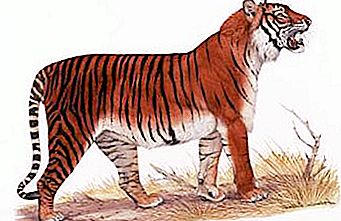The biggest cats on Earth are tigers. Nowadays, several subspecies of different sizes and with fur of various shades are known. Three of them are extinct. Of particular note is the Balinese tiger. It was destroyed by man in the last century. This representative of cats is considered to be the smallest tiger that existed on Earth.
Origin
Two theories of the occurrence of this subspecies are known. Supporters of the former tend to think that the Balinese and Javanese tigers originally had a common ancestor. However, during the Ice Age they were isolated from each other on different islands. Thus, on one was formed the Balinese subspecies, on the other - Javanese.

According to the second theory, the ancient ancestor of these tigers came to a new habitat from other lands, crossing the Bali Strait, which stretches for 2.4 km. This statement completely refutes the well-known myth that absolutely all cats are afraid of water.
External description. Breeding
The Balinese tiger differed from its relatives in small sizes. In length, the males reached 120-230 cm, the females were smaller, only 93-183 cm. However, even such sizes of a predator inspired fear in the local population. The weight of the beast did not exceed 100 kg in males, and 80 kg in females.
Unlike other relatives, the Balinese tiger had a completely different fur. It was short and deep orange. The number of stripes is less than usual, sometimes dark spots were found among them.
The female’s pregnancy lasted 100-110 days, there were always 2-3 kittens in the litter. They were born blind and helpless, weighing up to 1.3 kg. But closer to the year they themselves hunted down the prey and hunted. However, together with the tigress remained up to 1.5-2 years. These feline representatives lived for about 10 years.
Habitat
The habitat of the Balinese tigers was Indonesia, the island of Bali. This subspecies has never been seen in other territories.

He led a lifestyle similar to the rest of the feline. Preferred beast solitary and stray lifestyle. He stayed in one place for several weeks, then went off in search of a new one. Extinct tigers marked their territory with urine, which showed the belonging of specific places to a particular individual.
They were big lovers of water. In hot weather, constantly bathed and swam in the ponds.
Food
The Balinese tiger was a predator. He hunted alone, but in rare cases during the mating season he went for prey with his female. If there were several individuals at once near the caught animal, then it was a tigress with offspring.
Like other representatives of the species, it was a fairly neat cat, which monitored the condition of its fur, periodically licking it, especially after meals.
During the hunt, two methods were used: sneaking and waiting for the victim. The masking color helped the tigers to track down prey. Most often they hunted near ponds and on trails. Sneaking up to prey in small careful steps, the tiger made several large jumps and overtook prey.
While waiting, the predator lay, and when the victim approached, made a quick jerk. In the case of a miss of more than 150 meters, he did not pursue the animal.

With a successful hunt, like other large cats, an extinct subspecies of tigers gnawed its prey throat, often breaking its neck. At a time, he could eat up to 20 kg of meat.
When moving the killed victim, the predator carried it in the teeth or threw it behind its back. The tiger went hunting at dusk or at night. All the techniques used in this were the result of mother's education, and not an innate form of behavior.
On its territory, the Balinese tiger was the top of the food pyramid, rarely anyone could compete with this beast. For himself, only people represented danger.




